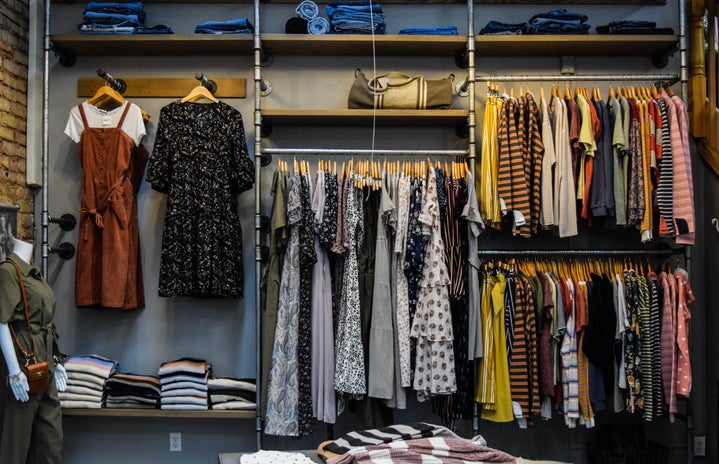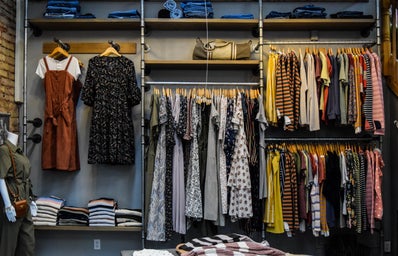As the temperatures are starting to drop and we are slowly inching toward snowy days, everyone is starting to pull out their UGG boots, cozy sweaters and heavy coats. However, have you ever thought about where the wool in your clothing comes from?
We have all heard about the cruelty of the fur industry. In the past, I voiced my opinions on animal derived fabrics, specifically leather, when I wrote an article titled, “The Truth About Leather in the Fashion Industry.” (Click here if you would like to give it a read.) In that article, I expressed my frustration with the fact that even though fur is recognized as being unethical and inhumane, the fashion industry does not accept the fact that the same things are true with regards to other kinds of animal derived fabrics, such as leather.
In my Fashion Fabrics class this semester, we discussed a lot about natural protein fibers, especially wool. My professors repeatedly mentioned that shearing sheep for wool is not harmful to the sheep in any way. This made no sense to me because if the sheep were being sheared, and their wool was being removed to be made into fabric for humans to stay warm, what was protecting the sheep from extreme temperatures? I did not believe my professor, and I could not help being skeptical because the fashion industry is known for exploiting animals and somehow getting away with it. Designers still continue to make leather products, even though it is very clear that the leather industry is brutal and unethical. Once again, I decided to conduct some research about the wool industry, and what I discovered is appalling and truly horrifying.
According to World Atlas, around 25% of the world’s wool is sourced from Australia. The country also produces more than 50% of the world’s merino wool, the most luxurious, high quality wool that comes from Merino sheep and is prized for its softness and luster. Between 2012 and 2014, animal rights organization PETA carried out several undercover investigations at many different sheep shearing sheds in Australia. They were even able to secretly document their investigations on video. A five minute video compilation was released in 2014 that clearly uncovered signs of abuse towards the sheep in six of the ranches in Australia.
Warning: The following paragraphs, taken from PETA’s website, may be graphic.
“Shearers were caught punching, kicking and stomping on sheep, in addition to hitting them in the face with electric clippers and standing on their heads, necks and hind limbs. One shearer was seen beating a lamb in the head with a hammer. Another even used a sheep’s body to wipe the sheep’s own urine off the floor. Yet another shearer repeatedly twisted and bent a sheep’s neck, breaking it.”
According to PETA, “within weeks of birth, lambs’ ears are hole-punched, their tails are chopped off and the males are castrated,” all without any painkillers. Newborn lambs are separated from their mothers to be sheared for their wool because lamb’s wool is so desirable, and many sheep die due to premature shearing.
In today’s materialistic world, especially in the fashion industry, companies want to keep producing more products and making more money. As a result of this mindset, sheep are not treated as animals, but as a means for these companies to produce more wool.
They are treated as “wool-producing machines” (PETA).
Shearers are usually paid by the volume of wool they provide, not by the hour. Due to this, they try to work as fast as possible all while not caring about the sheep’s well-being. Their quick, violent work often leads to severe cuts and wounds on the sheep’s bodies. Sometimes, in their hurry, shearers also cut off large parts of their skin, possibly their tails and ears, to obtain the wool as quickly as possible. If the workers do decide to close a wound, they use a needle and thread to hastily sew the wounds shut, without administering any pain killers.
After the wool has been obtained, the unwanted Australian sheep are then shipped to the Middle East on extremely crowded and filthy boats, to countries without any animal welfare laws. The suffering sheep are dragged off the ships, crammed into trucks and physically dragged to unregulated slaughterhouses, where they are killed for meat.
The industry also raises environmental concerns. Raising animals for wool also requires a lot of land for pastures, thus resulting in a lot of waste matter and excrement, which in turn creates methane gas. In New Zealand, methane emissions from raising sheep account for more than 90% of the country’s greenhouse-gas emissions. Clearly, the wool industry is not only harmful to the sheep, but to the planet.
If sheep were left alone to live their lives, and not genetically manipulated and bred to produce excess wool, they would grow the perfect amount of wool that is enough to protect them and keep them warm in cold weather. Their fleece insulates them throughout the winter and then they naturally shed it in the summer. However, humans take their wool for our own advantage, and forget that they need it to survive.
Although it can be difficult to find vegan wool options, there are quite a few available in the market, including bamboo, TENCEL®, hemp, acrylic, polyester, modal, rayon, viscose and cotton. I do understand that for some people who live in extreme cold weather, wool may be the only option to survive through the winter. Nevertheless, I think it is so incredibly crucial for us as consumers to be aware of what actually goes on behind-the-scenes, since the fashion industry always sweeps issues like this under the rug. I believe it is important that we understand where the clothes and accessories we wear comes from.
Animal cruelty is an issue that is incredibly close to my heart, so I hope I was able to provide you with some insight into this issue and a new perspective on the wool industry.
If you would like to read more about the wool industry, check out these sources:
The Wool Industry: PETA.org
7 Reasons Wool Is Cruel, Unnecessary & Just Plain Baaaa-d: Bustle.com
PETA: There’s No Such Thing as Humane Wool: NBCNews.com
5 Alarming Facts About the Wool Industry: OneGreenPlanet.org
Think wool is harmless? Think again: TheEthicalMan.com



